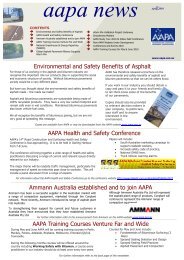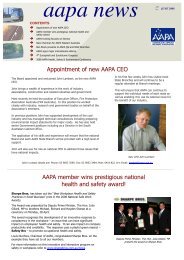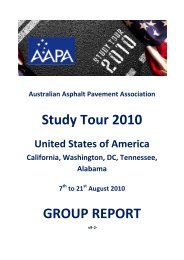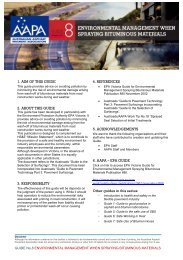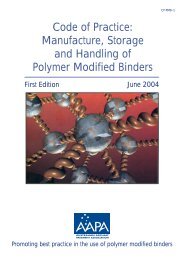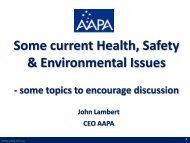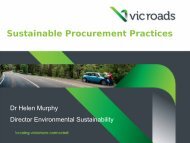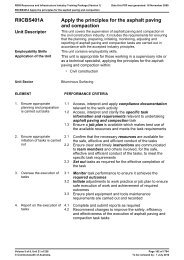Asphalt Review - Volume 32 Number 3 (Jun / Juy 12) - Australian ...
Asphalt Review - Volume 32 Number 3 (Jun / Juy 12) - Australian ...
Asphalt Review - Volume 32 Number 3 (Jun / Juy 12) - Australian ...
You also want an ePaper? Increase the reach of your titles
YUMPU automatically turns print PDFs into web optimized ePapers that Google loves.
ASPHALT REVIEWthe test track have not only demonstratedexcellent performance for this premium,heavy-traffic mix; many of the experimentshave provided clear evidence that manydifferent aggregate sources can be used,which has helped reduce mix costs.Alternative Binders andBinder ModifiersA number of alterative binders andmodifiers were evaluated on the 2009 testtrack to help reduce the quantity of virginasphalt binder needed for construction.Two alternative binders—Shell Thiopave, awarm-mix sulfur technology, and TrinidadLake <strong>Asphalt</strong>, a natural asphalt from Trinidadand Tobago—both successfully replacedrefined liquid asphalt in three sections.Kraton Polymers sponsored a sectionon the 2009 track that utilized highlypolymer-modified (HPM) mixes that werevery stiff yet strain-tolerant. The pavementwas designed with an 18% thinner crosssectionand exhibited excellent fatigue andrutting resistance.Other sections on the 2009 trackcompared binder modification with groundtirerubber (GTR) and styrene-butadienestyrene(SBS) polymer using laboratorytesting and field measurements. GTR,a more sustainable option, performedcomparably to SBS mixes in every aspect.Structural DesignPerpetual Pavements.Test track research has shown that pavementscan withstand higher levels of strain thansuggested by lab tests without accumulatingfatigue damage, allowing perpetualpavements to be designed with thinnercross sections.Two test sections placed in 2003 that wereexpected to reach the end of their life at 10million ESALs have survived 30 million ESALswith minimal rutting and no fatigue cracking.Several sponsors have used pavementdesigns based on the PerRoad softwareto establish pavement thicknesses using avariety of pavement materials. All of thosesections have performed as expected with nodamage through multiple cycles.<strong>Asphalt</strong> Layer Coefficient.Recent test track research showed that the0.44 asphalt structural coefficient shouldbe increased to 0.54, resulting in an 18.5%reduction in pavement thickness.This conclusion was reached afterevaluating the structural performance oftest sections representing a broad range ofasphalt thicknesses, mix types, bases andsubgrades. States that are not yet ready toimplement the Darwin-ME Pavement DesignGuide can save millions in construction costsby implementing the revised coefficient.Open-Graded Friction Course.Many highway agencies are aware of thebenefits of open-graded friction coursemixes (OGFC), such as reduced waterspray, improved skid resistance, and lesstire-pavement noise, but the structuralcontribution of OGFC was previouslyunknown. During the 2009 test track cycle,structural characterization of a sectioncontaining OGFC, or porous friction course,indicated that the OGFC does contribute tothe structural integrity of the section.States that previously have not attributedany structural value to OGFC can now use aprovisional OGFC structural coefficientof 0.15.Test track research also showed thatopen-graded friction course can improve apavement structure’s resistance to topdowncracking. Placing the OGFC with aheavy tack coat using a spray paver, ascompared to conventional tack methods,further improved performance of thepavement.Speed and Temperature Effectson Pavement Response.It is well known that both temperatureand vehicle speed have a significant effecton flexible pavement response to loading.However, theoretical pavement models,which are used to determine pavementresponse and ultimately predict pavementlife, often fail to accurately characterizespeed and temperature effects, resulting inerroneous predictions.Modeling with non-conventionalmaterials, such as sulfur-modified mixes,polymer-modified mixes, and WMAtechnologies can add uncertainty.Test track results showed that nonconventionalmaterials behave similar toconventional materials, so existing loadresponsemodels do not have to be adjustedfor special mixes. However, the effects ofspeed and temperature must be taken intoaccount. It should be noted that the specificpavement response models developedbased on test track conditions are uniqueto the climate, pavement cross-section,and loading conditions used at the track.However, the form of the models could beapplied to other conditions.MEPDG Predictions vs ActualPerformance.Evaluation of structural sections from the 2003and 2006 test cycles using the mechanisticempiricalpavement design guide (MEPDG)showed mixed results. Rutting was overpredictedprimarily due to errors in expecteddeformations in the base and subgradepavement layers. New calibration coefficients(βs1, βs2 = 0.05) appear to improve thepredictive capability and, when excludingsome outliers, resulted in reasonably accuraterutting predictions.Predictions of fatigue cracking were lesssuccessful; no better coefficients than thenational coefficients were found, resultingin poor agreement between measured andpredicted cracking. Better calibration resultsmay be achieved by grouping togethersections with similar characteristics.Prediction TestingThe Energy Ratio concept, developed inFlorida, was validated at the test track,enabling mix designers to successfully screenmixtures for top-down cracking potential.Test track results have been correlatedwith the <strong>Asphalt</strong> Pavement Analyzer,Hamburg wheel-tracker, and Flow <strong>Number</strong>tests to provide confidence in the twomethods as rutting predictors and forestablishing mix design criteria.Tire-Pavement InteractionNoise levels generated from tirepavementinteraction are influenced bymacrotexture, in-place air void content and,at low frequencies, by nominal maximumaggregate size. The ongoing noise analysisconducted during the 2009 test track cycleindicated that coarser surface mixtures,including OGFC, SMA, and coarse-gradedSuperpave, are noisier pavements at lowfrequencies. However, OGFC mixes werefound to be the quietest pavement athigher frequencies.The sound-intensity level (SIL) noisecorrelated well with the sound-pressure level(SPL) at all third-octave bands from 315 Hzto 4,000 Hz. Additionally, pavement surfacetexture (MPD) significantly affected SIL atlower frequencies (below 1,600Hz), with ahigher MPD having a positive effect on SILbelow 1,600 Hz and a negative effect on SILabove 1,600 Hz. ■46 ROADS JUNE/JULY 20<strong>12</strong>



